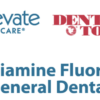4 Minutes for a Lifetime Why Our Oral Cancer Screening Practices Must Evolve!

Oral and oropharyngeal cancers continue to escalate with trends showing a shift in both etiologic pathways and patient profile.

Oral and oropharyngeal cancers continue to escalate with trends showing a shift in both etiologic pathways and patient profile.

Dr. Robert Martino discusses the use of new oral health care products and rinses that can make a huge difference in patient outcomes. He also focuses on patients in orthodontic treatment.
